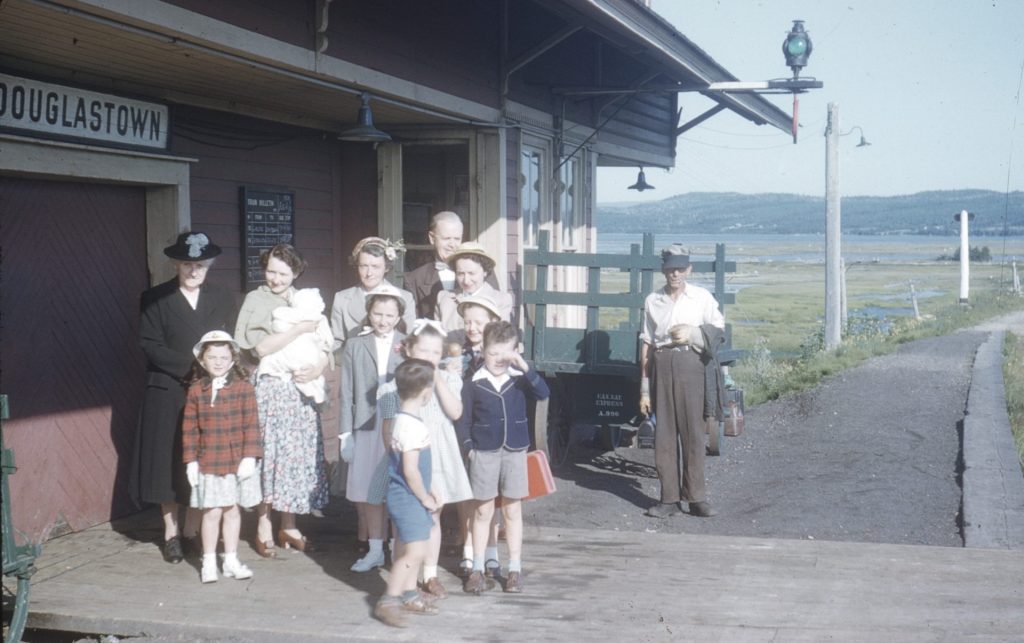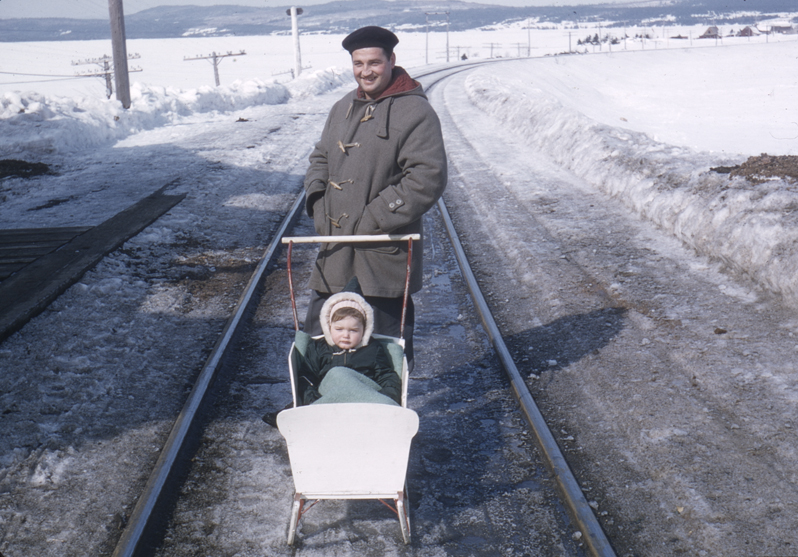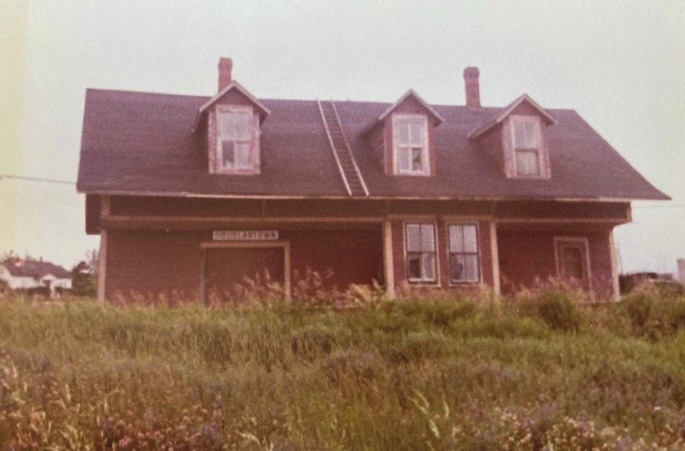
Memories of the Bygone Douglastown Railway Station
I spent the first 16 years of my life at our family home in Douglastown which overlooked the railway station and Gaspé Bay just beyond. My first memory of the station dates back to the 1950’s, when I was about 5 years old. My sister Nina and I were playing outdoors when we stopped to see the train pull into the station. The massive, coal-burning locomotive engine looked to be as big as the station itself. It clanged and belched out a huge plume of black smoke. The engineer blew the steam whistle and for some reason, on that particular day, we were terrified and ran behind our house to hide.
Vincent Agnesi
Originally from Douglastown

Our railway station was owned and operated by the Canadian National Railways (CNR). It was located near the bottom of the hill on which the village of Douglastown sits. Its exterior wooden clapboards were painted in the traditional maroon color for a railway station and it had a black roof. The east end of the building was the freight room which was accessed by a large sliding door. The center of the building was the station agent’s office. His huge desk was in front of a window that overlooked the tracks so that he could readily see the comings and goings. The west end of the station was the public waiting room. Two of its walls had large windows under which sat long wooden benches. In the center of the room was a coal burning stove which kept the room at a very cozy temperature, even on the coldest winter days. The upstairs was reserved for the station agent and his family. From their quarters they had an unobstructed view of Gaspé Bay and what was to become Forillon Park across the Bay.
In the 1950s and 60s, when not everyone had a car and there was no regular bus service, our railway station was our crucial link to the outside world. It was in fact the transportation hub of our town. A place of:
Great joy, especially in the summer months, when friends and relatives, would come back home by train for a vacation, as well as fellow students who returned home from higher studies at the end of their school year. Whenever we heard the train pulling into the station, we usually stopped to see who was arriving or departing and the word would spread from there.
Sadness, when these same visitors had to board the train to leave again and especially when someone was leaving home for the first time, usually to find work or continue their schooling. I remember once when I was leaving by train, my sister Florence and my parents came with me to the station to see me off. When the conductor checked my ticket, he commented that this was typical of a small town, in that several people came to the station but only one person was actually boarding the train.
Commerce, where you could purchase your ticket, as well as send and receive larger parcels. The three local general stores, owned and operated by Maro Agnesi, Cormick Kennedy and Frank Kennedy, were totally dependent on the railway to bring them all the merchandise they needed for their customers, everything from groceries, dry goods, hardware, feed for livestock etc. etc. It all came in by rail, was stored in the freight room at the station until they came to pick it up. At a time when telephone service was not overly reliable and long-distance calls had to go through an operator, some people went to the station agent to send or receive a telegram. They were usually short, printed messages announcing a birth, death or some other event of consequence.
The station agent was also responsible for assigning the empty boxcars on the siding to the local truckers, who loaded countless boxcars with 4-foot pulp for shipment to the Gaspesia Pulp and Paper Mill in Chandler. In late fall, the local farmers brought in truck loads of spruce and balsam trees to be graded and then shipped to the Christmas tree market in the United States.

Employment, for station agents such as Marc Gendron, Lionel Tardif and Fernand Giroux to name only a few who served in my time. In addition, local men were hired to maintain the tracks in their assigned section. Men such as Hubert Bond, Tom Gaul, Gerald Drody, Alphonse Matte and Cyril Rail worked on the section gang whereas Aaron Drody was a railroad engineer.
My mother told me that in the 1930s and 40s the mail came in by train every evening. Her mother, Laura Trachy, operated the post office out of a room in her house. Someone would fetch the mail bags from the station. In the meantime, some of the younger men of the village would gather at her house. They said they were there to pick up their mail, but it was likely that they were more interested in my grandmothers 8 daughters and to socialize and get the latest news.

The Douglastown station was decommissioned in 1964. The CNR had already begun to rationalize its services. With the advent of regular bus and airplane service and the growth of the trucking industry, the train was losing popularity. The proximity of the Douglastown station to the Gaspé station, a trip of about 15 minutes, probably worked to the disadvantage of the former. Sadly, our railroad station in Douglastown has since been demolished. For many, many years it served us well. It was an integral center of activity in our village, every bit as important in our daily lives as our church, school and general stores.
Thanks to Florence Agnesi for her collaboration and to Vision Gaspé-Percé Now and Jules Chicoine-Wilson for the translation.
Photos (in order)
Agnesi family at the Douglastown train station, 1953. In the foreground are Nina and Vincent Agnesi, children of Vida Trachy, and in the background, Laura Trachy and her daughter Vida holding her son Dennis.
Musée de la Gaspésie. Fonds Famille Agnesi de Douglastown. P306/3/3/1,2-8
Lionel Tardif, Douglastown stationmaster, on the railroad tracks with his daughter Huguette, 1956. Later, he will be stationmaster in Cap-d’Espoir and New Carlisle.
Musée de la Gaspésie. Fonds Famille Agnesi de Douglastown. P306/3/3,1-53
Douglastown train station when it was closed and abandoned, 1979.
Photo: Lionel Tardif
Bruno Tardif Collection